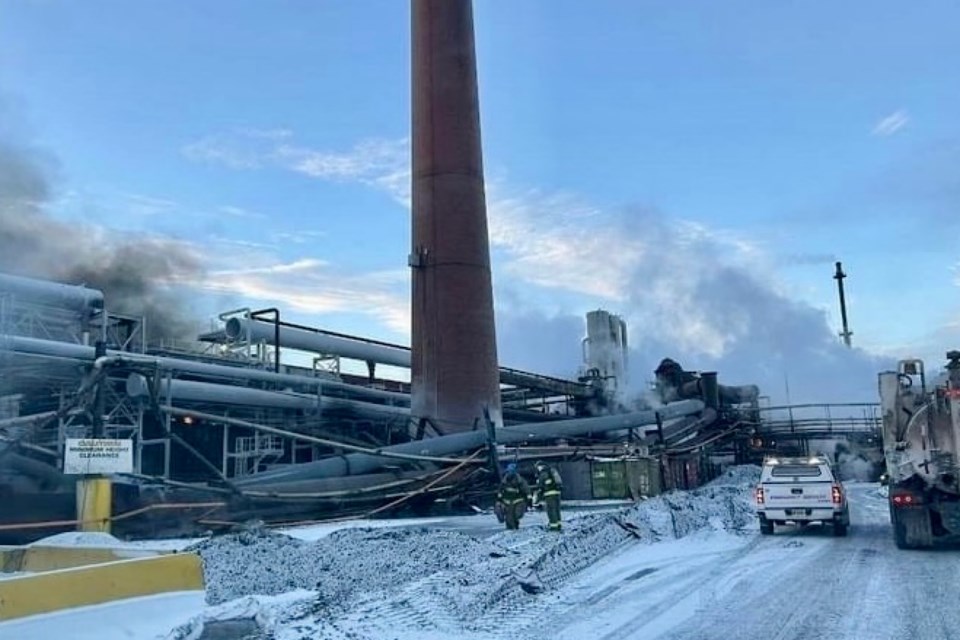It will be a "few weeks" before toxicity results are available from water samples taken over the weekend at Algoma Steel's wastewater treatment plant, Ontario's Ministry of Environment, Conservation and Parks tells SooToday.
"On January 20 at 8:30 a.m., MECP staff collected samples at the wastewater treatment plant for water quality and toxicity testing," said a statement provided to us by Gary Wheeler, ministry spokesperson.
"Ministry sample results will not be available until samples are processed, likely in a few weeks time," the statement said.
"The company also collected samples at that time and will be reporting their results to MECP when available."
The ministry statement contained a more detailed explanation of the 'flushing liquor' spill that occurred during an early-morning piping collapse on Saturday, and why it's not believed to pose any danger to residents of Sault Ste. Marie or communities downstream (east) of here:
Flushing liquor is made of water and contaminants from coal that are generated in the coke-making process.
Flushing liquor is used in the by-products plant to cool coke oven gas, recover valuable chemicals and remove sticky and corrosive components created in the coke-making process.
Flushing liquor is reused in the process after being reconditioned in the by-products plant, and flows in a closed loop system.
When flushing liquor is involved in a spill to the aquatic environment, the main contaminants are ammonia and phenols.
If flushing liquor is released in a spill at Algoma Steel, it is caught by onsite sewers and flows to the wastewater treatment plant.
The wastewater treatment plant (called the main water filter plant) collects and treats wastewater from storm water drains around the facility and many of the process areas at the mill, and any flushing liquor at the plant would be further diluted by the other wastewater sources.
Flushing liquor can be tracked by using ammonia levels from samples taken at the wastewater treatment plant.
When ammonia levels return to normal, it is a sign that there is no more flushing liquor at the treatment plant and that the impact of the spill is over.
The January 20 spill was caused by the piping collapse.
The company took steps to prevent the spill from flowing to onsite sewers by blocking access with berms, which meant the spilled liquor was contained in pools on the ground and no longer flowing to the wastewater treatment plant.
Sault Ste. Marie's drinking water comes from both surface water and groundwater sources (wells), with about half coming from surface water.
Lake Superior water is drawn at Gros Cap, which is upstream of the steel plant discharge.
The location of the intake protects Sault Ste. Marie's surface water supply from any discharges from Algoma Steel’s wastewater treatment plant (main water filter plant) and onsite sewer drains.
Yesterday, the steelmaker said it currently believes there is "a low risk of impact to the adjacent waterway."
Today, Sault MP Terry Sheehan announced details of Service Canada clinics to help expedite employment insurance benefits for the estimated one-quarter of Algoma Steel's 3,000 employees will be temporarily laid off because of the weekend pipe collapse and halting of production at its #7 blast furnace.
In other news, a second law firm has announced a class-action investigation into the weekend pipe collapse and a drop in Algoma's share price that occurred on Monday.
Bronstein, Gewirtz & Grossman is asking investors to contact them if they are aware of facts related to the investigation.
Pomerantz LLP, another law firm known for aggressively pursuing class-action suits, made a similar announcement on Monday.
No allegations have been tested in court and Algoma Steel is presumed innocent unless proven guilty.
